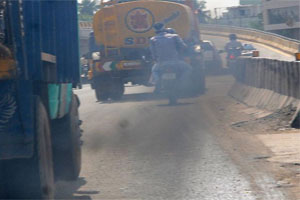India's Vehicular Pollution Among The Worst In The World

BANGALORE: India’s environmental and public health experts are constantly warning that an explosion in the number of motorized vehicles on the country’s roads is threatening the health and economic security of its masses. As such, stringent laws are necessary to control vehicular pollution, reports Snehal Rebello of Hindustan Times.
As per the study conducted by U.S.-based Desert Research Institute (DRI) and the Indian Institute of Technology (IIT), Delhi, India should implement stringent emission control guidelines similar with those in the developed nations like United States and European Union countries. This is in regards to the estimated five-fold increase in vehicles between the years 2011 and 2030.
To ensure stringent pollution control measures and use of cleaner fuel in vehicles, by 2015 end, around 50 Indian cities are likely to adopt the Bharat IV norms.
Presently, just 17 cities, along with the major metros, follow the Bharat IV norms. Other cities follow the Bharat III guidelines.
To add to the woes of the people, the study further reveals that in India, the number of vehicles is likely to increase from 90 million in 2011 to 450 million in 2030. This means number of fine particles or particulate matter emission is estimated to rise up from 2,53,000 to 3,50,000 million tonnes in the same period.
Without much delay, the government should try to implements the usage of Bharat V standards by 2015 all over the country regardless of its scheduled period of 2025.
In this way, the rising pollution level could be controlled and can drastically bring it down too, says DRI-IIT study.
Not just this, it would also alleviate Particulate Matter (PM) 2.5 at the 2011 levels despite the five-fold rise in vehicular density.
Also Read:
India Among World's 10 Most Dangerous Countries For Journalists
10 Political Honchos Who Were Humiliated In Public

.jpg)

